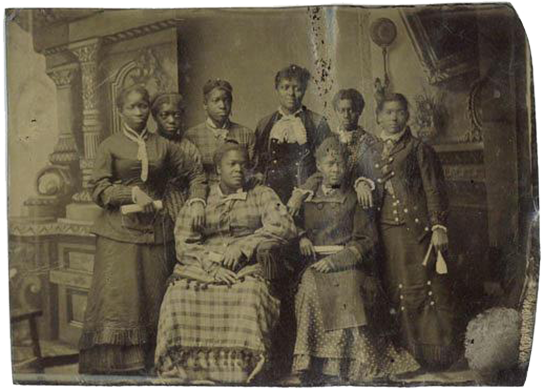“The camera is an instrument that teaches people how to see without a camera.”
—Dorothea Lange
Photographs are one of my favorite tools to use as a museum educator. One technique I like to use, known as a Visual Thinking Strategy (VTS), is a very simple and effective way for people to start to see more in an image than they otherwise would have noticed. There are three main steps to follow:
- Show an image to your audience—either project it on a screen in front of a classroom, or pass it around so everyone can get a good look at the details.
- Ask students to sit silently and look closely at the image for a minute or two.
- Guide the students through a series of questions that help them think critically about the image and start asking questions of their own.
We might start with an image like this one:

Tintype portrait of unidentified group of African American women. SHSND 10737-310.
After taking in all the details for a couple of minutes, I would first ask my audience to tell me what is going on in the photograph. It is important that we don’t tell them what we want them to know. We have to be patient and let them make observations; compare and contrast their own answers; and start asking questions. We can keep the conversation going by asking follow up questions—“What makes you say that?” and “What more can we find?” This will help students continue their observations and will help them associate details in the image with their own personal experiences or prior knowledge.
This is a great activity for teachers of any discipline. English teachers can use this activity to initiate a creative writing activity. Science teachers can use this to connect observations of an image to classroom lessons such as identifying physical properties of an object. Math teachers can use images this way to help make connections for students between the real world and abstract concepts—for example, you could ask younger students to find basic shapes or to add or subtract the number of items in an image.
This exercise is great for someone teaching North Dakota Studies or other history classes. We can talk about the clothing and interior décor styles of past decades. We can talk about how a historian or archivist could do some detective work to try to find out more about who these unidentified women are. We could even talk about the preservation of historic images, and the process used to create a tintype.
Using a strategy like VTS gets people to start noticing details and interpreting what is going on in an image. Students begin to understand how other people might have a completely different understanding of what is going on in an image than they did. I always try to pair appropriate images to any lesson I’m teaching so that students start to exercise their history detective muscles. It can spark an interest in students of all ages.

